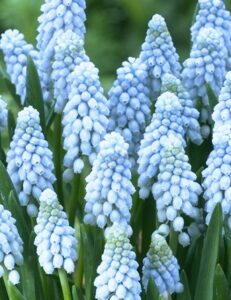 It is clear from even a brief tour around the garden that extensive squirrel landscaping has happened over the past half year. Little “tommie’ crocuses, or Crocus tommasinianus, sprouted weeks ago in the lawn and other areas far removed from where the bulbs were originally planted. Now, having played their role in the early spring bulb parade, the “tommies” have subsided. The grape hyacinths have taken their place, and many of the bulbs have either sprouted legs and walked to random yard and garden locations, or been “planted” by squirrels.
It is clear from even a brief tour around the garden that extensive squirrel landscaping has happened over the past half year. Little “tommie’ crocuses, or Crocus tommasinianus, sprouted weeks ago in the lawn and other areas far removed from where the bulbs were originally planted. Now, having played their role in the early spring bulb parade, the “tommies” have subsided. The grape hyacinths have taken their place, and many of the bulbs have either sprouted legs and walked to random yard and garden locations, or been “planted” by squirrels.
I sometimes feel as if I am following phantom squirrels around the yard, undoing their random acts of horticultural installation. Fortunately, the wandering grape hyacinths are easy to relocate, and they seem to flourish no matter what the situation
Most of my grape hyacinths are the most common species, known botanically as Muscari armeniacum, or, in some sources, Muscari botryoides. A certain amount of name-related confusion seems to reign in the horticulture trade, but common “grape hyacinths” are characterized by “grapes”, which are dark, blue-purple bell-shaped flowers clustered into a tight, narrow cones at the top of each slender stalk. Theoretically, grape hyacinths grow between six and eight inches tall. In my garden, the earliest ones generally top out at about four inches. As the weather warms up, later flowering plants will be taller—generally to about six inches. Whether they are short or slightly taller, grape hyacinths are nothing if not prolific.
Like daffodils and some other well-loved spring-flowering plants, grape hyacinths are long-lived. Established clumps, left on their own, will naturalize and often outlive the individuals who planted them. You can also dig up a clump and take it with you when you move from one house to another. Positioned in a sunny spot, or even under a deciduous tree, the clump will start the business of making itself at home immediately and reproduce without any intervention—except possibly by squirrels—at all.
Muscari is part of the Asparagaceae family, home to that other spring favorite, edible asparagus. Both are harbingers of spring. Muscari armeniacum, not surprisingly, hails originally from Armenia and other parts of southeastern Europe. Garden and plant historian Denise Wyles Adams says that the plants were introduced in 1596, which means that they have been around in domestic cultivation somewhere–probably in Europe, as well as their native areas–since long before that.
Anything that has been popular for as long as grape hyacinth will have attracted the attention of amateur and professional plant breeders. Plant merchandisers carry a number of varieties every year. I am very partial to the classic ‘Valerie Finnis’, which is big—sometimes as tall as eight inches—bold, and pale blue, making a nice contrast with its darker relations. ‘Baby’s Breath’ is an even lighter shade. If pink is your cup of tea, try ‘Pink Sunrise’. White-flowered varieties like ‘Siberian Tiger’ play well with grape hyacinths in other shades.
In the bi-colored domain, ‘Touch of Snow’ is dark blue-purple with a lighter blue topknot. A related species, Muscari latifolium, offers white “grapes” atop a lighter purple base.
And then there are those gardeners for whom nothing succeeds like excess. For them, merchandisers carry double varieties like ‘Blue Spike’, which looks as if someone stuck the end of the stalk into a live electrical outlet. Another double with bi-colored blue and white flowers is ‘Double Beauty’. Muscari plumosum ‘Plumosum’ offers a similar appearance in a shade that is more plum than lavender.
Other alluring grape hyacinths include Muscari azureum, which features slightly looser flowerheads striped in pale and darker blue. The unfortunately named Muscari neglectum is a tri-color, with lower florets that are purple-black edged in white, and upper florets of lighter blue-lavender. Muscari macrocarpum ‘Golden Fragrance’ is true to its varietal name, with lower bell-shaped florets of yellow-gold and topknots of purple.
Once you have identified varieties that you like, the most important thing to remember is to buy lots of the little bulbs. Start with at least 50 and plant them in odd numbered groups in locations where they will be easy to see. The edges of garden beds are excellent spots, as are rock gardens or containers. They also grow very well in containers. Plant in the fall, and place the pots in cool locations like unheated garages or protected porch corners. They will begin sprouting in early spring. In-ground or in containers, the ephemeral nature of the flowers and foliage means that the whole grape hyacinth show will be over by the start of summer, at the latest.
If you already grow grape hyacinths and want to increase supplies, divide them within the next few weeks, just as bloom time ends. Dig up an entire clump, divide them into two or three rooted divisions and replant. It’s as easy as that. Grape hyacinths are fall-planted bulbs, but it pays to think about them now when you can see likely spaces for them in the garden. Vendors start offering these and other spring beauties now or within the next few weeks, and sometimes provide discounts to early-bird orders. Van Engelen/Scheepers has a good selection. Find them at 23 Tulip Drive, P.O. Box 638, Bantam, CT 06750; (860) 567-8734; www.vanengelen.com. Another great source is Brent and Becky’s Bulbs, 7900 Daffodil Lane | Gloucester, VA 23061; (877) 661-2852; www.brentandbeckysbulbs.com. Both companies offer print catalogs.
